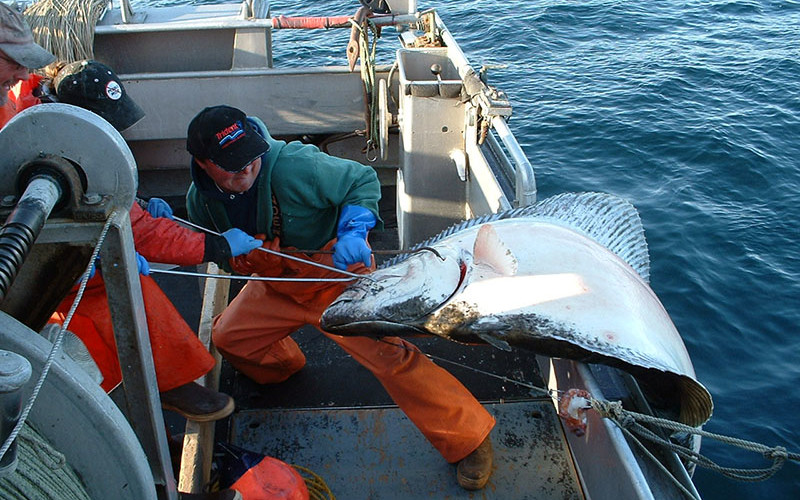Alaska’s halibut and blackcod seasons began on March 15 and will run until Nov. 15, but the processing capacity and low ex-vessel prices may affect the flow of fish from the docks to end markets. As of March 26, the halibut fleet had landed 592,173 pounds of this year’s 17,296,000-pound quota, with blackcod deliveries sitting at 1,520,542 pounds of a 60,794,049-pound quota.
With the Trident Seafoods plant for sale in Kodiak, and openings of other processing facilities scheduled for mid-March or even mid-May, early season fish caught in the breadbasket production areas of the Central Gulf (blackcod) or Areas 3A and 3B (halibut) were landed in Juneau and Seward.
The lack of plants accepting product in the central harvest areas may mean that more fishermen won’t go fishing until they open, which would slow the pace of the harvest early in the season.
The good news for halibut is that all of last year’s product has been liquidated, according to Bob Alverson, general manager of the Fishing Vessel Owners’ Association, in Seattle.
“Inventories are all played out at the end of 2023, so it’s a good market forecast,” he says.
At the end of last year’s season, ex-vessel prices for halibut dropped to a range of $6 per pound to $6.75 at the docks in Bellingham and slumped to less than $5 per pound for deliveries to Seward.
“Prices have dropped at the dock all season while retail prices have remained at $19 to $24 a pound in Seattle and over $30 in Phoenix, Arizona,” according to Alverson’s report in the most recent edition of Wheelwatch, the FVOA newsletter.
Meanwhile, ex-vessel prices for deliveries of halibut to Seward in the first week of this year’s season ranged from $6.25 per pound to $6.75 per pound, with the highest prices paid for fish over 40 pounds.
The outlook isn’t quite as optimistic for blackcod. Ex-vessel prices in Juneau in March ranged from 60 cents per pound for small fish under two pounds; $1.10 for fish two and three pounds; $1.60 for three and four-pound fish; $2.35 for fish weighing four to five pounds; $4.00 for five to seven-pound fish; to $6.50 for fish over seven pounds.
“Sablefish prices are running lower than the end of last year,” says Alverson. Last year’s prices mark the low point in an abysmal trend in recent years, especially for the smaller fish.
“A fish ticket I pulled from 2017 showed dock prices ranging from $5.20 per pound for the small fish all the way to $9.90 per pound for fish over seven pounds.” says Maddie Lightsey, a broker with Alaska Boats and Permits, in Homer. “Towards the end of last season, folks were averaging as little as a dollar or two per pound.”
As the 2024 season unfolds, the halibut and blackcod fleet may leave a large portion of fish unharvested. Last year, the halibut fleet landed 15,125,658 pounds, which was 85 percent of its TAC (total allowable catch) of 17,806,000 pounds. The highest catch rates of 91 percent occurred in Areas 3A and 3B, while the lowest catch rate of 40 percent was in Area 4B. Meanwhile, the blackcod fleet landed 37,436,394 pounds, 60 percent of its TAC of 62,044,958 pounds.
Next year and beyond, the fleet stands to leave an even larger portion of the potential quotas unharvested. Recent blackcod population surveys point to a huge increase in biomass, which portends the recruitment of young 2-pound fish into the fishery.
Unfortunately, blackcod and halibut fall into the ailing market dynamics for seafood species across the globe. In the case of blackcod, some traders working the Japanese market are sitting on appreciable inventories in cold storage holdings in Japan.
“There is a big holdover from last year, up north,” says Scott Adams, general manager with Hallmark Fisheries, in Charleston, Ore. “Also, a lot of five to seven-pound fish left.”
A huge factor in exporting U.S. blackcod to Japan has been the steady devaluation of the yen. At the end of March, one yen was worth about 66 cents in U.S. dollars. That puts Japanese buyers at an extreme disadvantage in purchasing power for any commodity coming out of the United States, compared to when the yen and the dollar traded neck and neck a decade ago.
The bright spot for blackcod is that interest has been increasing on the domestic front. About two thirds of Alaska’s harvest went overseas to Japan in years past. Though it is unknown exactly how much goes into domestic markets now, the scales have been tipping toward interest in restaurants along the West Coast and elsewhere.
With the world awash in whitefish supplies, and an influx of product imported into the United States from Russia, China and other countries, price points among wholesalers, retailers and restaurateurs will determine what consumers put on their plates.
Adams reports interest among domestic buyers throughout March. Part of that interest stems from the price of Chilean sea bass, a close competitor with blackcod in West Coast restaurants.
“There’s more food service interest, I think, as the Chilean sea bass is so expensive.”







